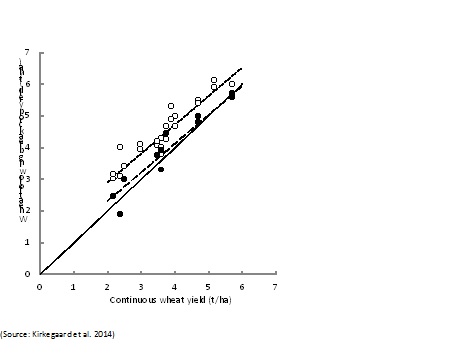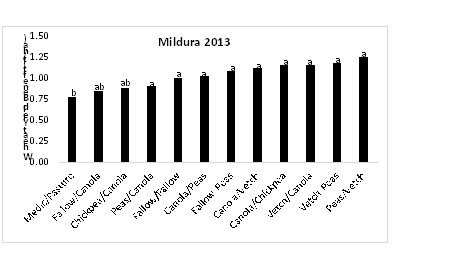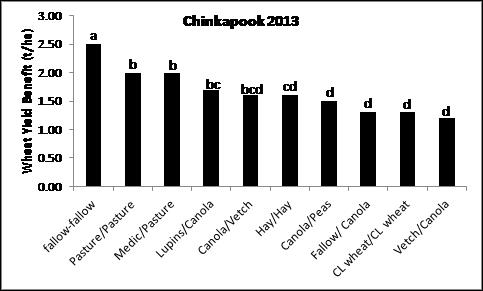Achieving success with break crops in the Mallee farming system
Author: Therese McBeath, Vadakattu Gupta, Rick Llewellyn, Bill Davoren, James Hunt, Roger Lawes, Claire Browne, De-Anne Ferrier and Michael Moodie | Date: 23 Jul 2014
Take home messages
- Combined analysis of trials hosted by BCG and MSF show that first year effects of legumes are generally more reliable than oilseeds for improving subsequent wheat yield.
- Increased nitrogen supply could be measured up to two years following the break and played a key role in the break effects at Karoonda and Hopetoun where weed burden was low.
- Disease breaks tended to only last for one wheat growing season.
- Sites with a high grass weed burden require a two year break to reduce the weed seed bank to a level that enables consistent improvements in cereal production.
- Measuring the gross margin of production over a three-four year period showed that the inclusion of legume and canola breaks in the sequence was at least as profitable as continuous wheat.
- Two year breaks can increase the variability in gross margins in the years breaks are implemented but significant profit gains compared to continuous wheat were made at both sites for a small selection of treatments.
Background
In the Mallee environment cereals are considered a lower risk crop option but relying on continuous cereal cropping can increase the pressures associated with managing weeds, disease and nutrition (Kirkegaard et al. 2014). Growing a break crop in the sequence can help to manage some of these pressures and provide improved cereal yield in subsequent seasons, but in a low rainfall environment growing a break can be riskier and in many cases return a lower annual gross margin than cereals. We combine the outcomes of four Mallee break crop trials to evaluate the fit of break crops in this environment. We measure the impact of the breaks on the performance of subsequent wheat crops and then explore reasons for that impact. Using this longer term view we were able to measure the returns from different crop sequences and demonstrate that the perceived riskiness of incorporating a break crop was reduced through the consistency in the effect of the break crop on subsequent wheat yields. We show that legumes provide more consistent break effects than canola; that the supply of nitrogen is a key driver of break effects and; that two year breaks are required when weeds are the main factor constraining continuous wheat yield.
Methodology
In the last five years, break crops have been evaluated at Karoonda in the Southern SA Mallee (2009 and 2010), Mildura in the Northern Victorian Mallee (2011 and 2012), Chinkapook in the Northern Victorian Mallee (2011 and 2012), Hopetoun in the Southern Victorian Mallee (2009, 2010 and 2011) resulting in nine years of break crop site-year data with the effect of the break crop on subsequent wheat production measured for up to three years. In addition, the effect of the break crop on the level of nutrition, diseases and weeds were measured at the trials at varying levels of intensity dependent on the key limiting factors at each site. The break crops grown at each site varied but included species of legume (vetch, field pea, lupin, volunteer pasture), brassica (canola, juncea) and grass (cereal rye, barley, oaten hay) (Table 1).
Table 1. Treatments at each field site. Not every combination tested at Mildura and Chinkapook is shown.
|
Site |
Site Average Annual Rainfall (mm) |
Factors Limiting Continuous Wheat Yield |
Soil Types |
Break Crop Year |
Break Crop Type |
Break Crop |
|---|---|---|---|---|---|---|
|
Karoonda |
337 |
Low N and organic matter, Moderate soilborne disease inoculum |
Deep Sand, sand over clay and clay loam |
2009 2010 |
Legume Pasture Cereal Legume Brassica Pasture Cereal |
Field Pea Volunteer Cereal Rye Lupin Canola Volunteer Cereal Rye |
|
Hopetoun |
342 |
Low N and organic matter, Moderate soilborne disease inoculum |
Sand over clay and clay loam |
2009 |
Brassica Legume Fallow Brassica Legume Fallow Brassica Legume Fallow |
Canola, Juncea Peas, Vetch Fallow Canola, Juncea Peas, Vetch Fallow Canola Peas, Vetch Fallow |
|
Mildura/ Chinkapook |
275/332 |
High weed density, Moderate soilborne disease inoculum |
Deep sand |
2011 (one year breaks) 2011-2012 (two year breaks) |
Cereal Brassica Brassica/Legume Legume Fallow |
Barley, Oaten Hay Canola Canola/pea mix Peas Fallow Canola-chickpea Canola-pea Canola-vetch Chickpea-canola Fallow-canola Fallow-fallow Fallow-peas Medic-pasture Peas-canola Peas-vetch |
Results and discussion
One year breaks at Karoonda and Hopetoun
A combined analysis of the effect of growing a legume or brassica break on subsequent wheat yield demonstrated that legumes provided a bigger yield effect than brassica (Figure 1). For a 2t/ha wheat crop the effect is approximately 0.9 t/ha additional yield following a legume break and 0.3 t/ha following a brassica break.

Figure 1. The relationship between yield of wheat following break crops and yield of continuous wheat at Karoonda and Hopetoun. Wheat yield following a Brassica break crop (●) was CW= 0.51 + 0.91 CW yield (dashed line), and following a legume break crop (○) was LW= 1.10 + 0.91 CW yield (dotted line) (P<0.001).
One year breaks trialled at Mildura showed benefits of 0.3 t/ha of extra wheat production following a legume or fallow and 0.1 t/ha following a brassica, but weed populations constrained cereal yields following a single-year break treatments (Moodie et al. 2014).
Two year breaks at Mildura and Chinkapook
Where weed populations were a major problem in continuous cereal, the break crop effect on cereal yield was large. These benefits were in the order of 0.75- 1.25 t/ha (continuous wheat yield 1.4 t/ha) in the first wheat crop grown after the two breaks at Mildura with two years of pasture returning the lowest benefit of the options tested (Figure 2). At Chinkapook the benefits were in the order of an extra 1.2 – 2.5 t/ha (where the average continuous wheat yield was 1 t/ha) and two years of chemical fallow returned the highest level of yield benefit while combinations of canola-peas, fallow-canola, two Clearfield (CL) wheats, and vetch hay-canola returned the lowest level of yield benefit (Figure 3).

Figure 2. The extra wheat yield (compared with continuous wheat) generated when two break crops were grown in the preceding two years at Mildura. Treatments that are significantly different are annotated by a different letter (P<0.05, LSD 0.30 t/ha).

Figure 3. The extra wheat yield (compared with continuous wheat) generated when two break crops were grown in the preceding two years at Chinkapook. Treatments that are significantly different are annotated by a different letter (P<0.05, LSD 0.40 t/ha).
Factors causing the break effect
Nitrogen.
Break crops at all sites influenced the supply of nitrogen to subsequent crops. Wheat following vetch was consistently a highest yielding treatment at Hopetoun and atmospheric nitrogen fixation was measured at 77 (clay)-132 (sand) kg N/ha. Peas also fixed lower but significant amounts of atmospheric nitrogen with 48 (clay)-124 (sand) kg N/ha (Browne et al. 2012). At Karoonda measurements of nitrogen supply potential showed that canola caused an increase in nitrogen supply potential (through changes in the microbial activity) for the subsequent crop (14-29 kg N/ha/season) over all three soil types while legumes increased nitrogen supply (11-20 kg N/ha/season) on the clay loam and sand over clay soils. In addition there were carryover benefits into the second year after a pasture break (16-23 kg N/ha/season) (Gupta et al. 2012). At Chinkapook there were variable changes in mineral nitrogen following breaks compared with continuous wheat which had substantial soil nitrogen at 100 kg N/ha. Of note, a two year fallow led to a significantly higher level of soil nitrogen (136 kg N/ha) in the subsequent wheat crop. At Mildura the use of legume breaks resulted in significant increases in 0-60 cm soil mineral nitrogen with an additional 45-55 kg N/ha compared with continuous wheat (which had just 10 kg N/ha).
Disease.
The main soil-borne disease detected at all sites was rhizoctonia. The inclusion of non-cereal break crops resulted in lowered soil-borne disease inoculum levels in subsequent cereal crops at all four sites. However, the effect of crop type on rhizoctonia disease incidence in the following wheat crop was variable and influenced by crop season. At Karoonda during 2010 when the rhizoctonia disease incidence was generally low, the effect of the 2009 break crop was not significant. A canola break in 2010 had the biggest effect of reduced disease incidence in the following 2011 wheat crop but this break effect only extended into 2012 on the clay loam soil type and not the sand (Gupta et al. 2012).
Weeds.
The primary grass weed pressure at both Chinkapook and Mildura was brome grass. By the end of 2013, the continuous wheat brome grass density at Chinkapook was 450 plants/m2. Two year breaks were better than one year breaks for reducing brome grass numbers and those that included legumes or Clearfield technology reduced brome grass numbers to very low levels (6-12 plants/m2) (Price 2014). The continuous wheat brome grass density at Mildura at the end of 2013 was 45 plants/m2 (but 108 plants/m2 for the wheat-barley sequence) and this was reduced to 6-14 plants/m2 with two year sequences that included legumes and brassica and 19-33 plants/m2 with sequences including a one year break (Moodie et al. 2014).
Economics of breaks in the sequence
One year breaks.
The recent rapid increase in break crops in the Victorian Mallee, in particular vetch for brown manure suggests that growers perceive that they are of economic value, and the outcomes of field trials in the Mallee region support this perception to some degree. At both the Hopetoun and Karoonda trial sites, where weeds were not a major constraint, three-four year sequences that included break crops were found to be at least as profitable as continuous wheat (Browne et al. 2012; Llewellyn et al 2013). There was a higher level in variability in return in the year that the break crop was grown due to the variability in both price and yield that is inherent in the production of break crops in the Southern cropping region. The profitability of including the legume in the sequence was derived from the impact of the legume on subsequent wheat yield while the profitability of including the brassica was a result of strong prices for canola in the years that it has been grown (Kirkegaard et al. 2014).
Two year breaks.
Three year gross margins at Chinkapook clearly demonstrate that while a two year fallow can generate substantial yield gain, the loss of two years of crop income has a high price. Sequences that included Clearfield technology had the best three year gross margin due to the major effect of reducing brome grass numbers. However, the potential risk and cost of the development of Group B resistance that may result from an over-reliance on this technology is not factored into this gross margin.
Three year gross margins at Mildura where brome grass was influential, suggest that most of the two year break options were at least equivalent to wheat and the breaks that generated the highest yielding wheat crop in 2013 (peas-vetch, canola-peas, canola-chickpea) generated up to an additional $316/ha/3 yrs.
Conclusion
Using a combined analysis of trials from across the Mallee environment we have shown that for a single year break, legumes are generally more reliable than brassicas for improving subsequent wheat yield. The legume break improved N supply. Two year breaks are required to manage weed seed banks effectively. Disease inoculum levels were lowered at all sites but the disease break effect tended to only last for one wheat growing season. The effects on nitrogen supply were measurable in both the first and second year following the break. Measuring the gross margin of production over a three to four year period showed that the inclusion of most break options in the sequence was at least as profitable as continuous wheat. There were several examples where the inclusion of breaks in the sequence resulted in substantial potential profit gains.
References
Browne C et al. (2012) Break crops pay in the Victorian Mallee. Australian Agronomy Conference, Armidale, NSW, 2012, Australian Society of Agronomy. http://www.regional.org.au/au/asa/2012/crop-production/7955_brownecj.htm
Ferrier D (2014) Mallee rotations that beat brome grass and make money. BCG 2013 Results Compendium.
Gupta V et al. (2012) Break crops for disease and nutrient management in intensive cereal management. Australian Agronomy Conference, Armidale, NSW, 2012, Australian Society of Agronomy. http://www.regional.org.au/au/asa/2012/nutrition/7961_vadakattugupta.htm
Kirkegaard J et al. (2014) Improving water productivity in the Australian grains industry- a nationally coordinated approach. Crop and Pasture Science.
Llewellyn et al. (2013) http://www.grdc.com.au/Research-and-Development/GRDC-Update-Papers/2013/07/Break-benefits-on-Mallee-soils
Moodie M et al. (2014) Two year break phases can boost wheat yields and profits. MSF 2013 Results Compendium. http://msfp.org.au/wp-content/uploads/2014/02/MSF1320.pdf
Moodie M et al. (2014) Mallee crop sequences influence soil nitrogen, rhizoctonia and brome grass. MSF 2013 Results Compendium. http://msfp.org.au/wp-content/uploads/2014/02/MSF1319.pdf
Contact details
Therese McBeath
CSIRO Waite Campus, PB No 2, Glen Osmond, SA, 5064
08 83038455
Was this page helpful?
YOUR FEEDBACK
